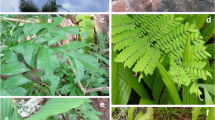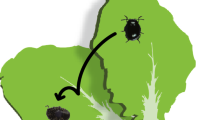Summary
The foraging behavior of females of the leaf miner, Agromyza frontella (Rondani), (Diptera: Agromyzidae) when encountering unexploited or exploited alfalfa plants was studied in large field cages and in laboratory bioassays. Females did not recognize any exploited leaflets before contacting them and did not distinguish between leaflets with an egg or first instar larva and unexploited leaflets, even after contact. Only one fly oviposited in leaflets which contained 80–120 nutrition holes, one late second or third instar larva or which were marked with an epideictic pheromone in field cages. In laboratory bioassays females oviposited less in leaflets containing a second or third instar larva or an empty larval mine than in unexploited ones. Females foraging on unexploited leaflets engaged in area-restricted search and 10 of 11 females remained on the test plant for the full 60 min of observation. However, females foraging on exploited plants were much more active, spent a greater proportion of their time searching for suitable hosts, had the highest rates of visitation to all above ground plant parts and emigrated to the cage walls before 60 min had elapsed. These quantitative measures of foraging behavior indicated that females ranked plants after landing on them in the following order: unexploited plants >plants marked with pheromone or with many nutrition holes >plants with late instar larvae. The order of host ranking by foragers was in general agreement with the suitability of the host plants for larval survival, development and reproduction, as estimated from previous laboratory studies.
Females of A. frontella foraging on unexploited alfalfa plants fed and oviposited significantly more often in the upper apical leaflets than in the lower, older leaflets. However, the choice of feeding site by flies on exploited plants did not vary with leaflet position (age), indicating that females fed in order to sample leaflet quality and that females investigated lower (older) leaves after they discovered that the preferred upper leaves were occupied. These data suggest that high quality oviposition sites may be limiting for A. frontella females, which could explain why superparasitism of leaflets sometimes occurs in nature, even when unexploited sites are available.
Similar content being viewed by others
References
Ahman I (1986) Oviposition in Dasinera brassica Winn. (Dipt.: Cecidomyidae). Adaptive, mechanistic and applied aspects. Ph.D. thesis, Swedish University of Agricultural Sciences, Uppsala, Sweden
Bell WJ (1985) Sources of information controlling motor patterns in arthropod local search orientation. J Insect Physiol 31:837–847
Bethke JA, Parella MP (1985) Leaf puncturing, feeding and oviposition behavior of Liriomyza trifolii. Entomol Exp Appl 39:149–154
Bond AB (1980) Optimal foraging in a uniform habitat: the search mechanism of the green lacewing. Anim Behav 28:10–19
Brockelmann WY (1975) Competition, the fitness of offspring and optimal clutch size. Am Natur 109:677–699
Bultman TL, Faeth SH (1985) Patterns of intra- and interspecific association in leaf-mining insects on three oak host species. Ecol Ent 10:121–129
Bultman TL, Faeth SH (1986) Experimental evidence for intraspecific competition in a lepidopteran leaf miner. Ecology 67:442–448
Charnov EL (1976) Optimal foraging, the marginal value theorem. Theor Popul Biol 9:129–136
Chew FS (1977) Coevolution of pierid butterflies and their cruciferous food plants. II. The distribution of eggs on potential food plants. Evolution 31:568–579
Condrashoff SF (1964) Bionomics of the aspen leaf miner, Phyllocnistis populiella Cham. (Lepidoptera: Gracillariidae). Can Ent 96:857–874
Cook RM, Hubbard SF (1977) Adaptive searching strategies in insect parasites. J Anim Ecol 46:115–125
Curio E (1976) The ethology of predation. Springer, Berlin
Drolet J, McNeil JN (1984) Performance of the alfalfa blotch leafminer, Agromyza frontella (Diptera: Agromyzidae) on four alfalfa varieties. Can Ent 116:795–800
Edwards PJ, Wratten SD (1983) Wound induced defenses in plants and their consequences for patterns of insect grazing. Oecologia (Berlin) 59:88–93
Faeth SH (1985) Host leaf selection by leaf miners: interactions among three trophic levels. Ecology 66:870–875
Faeth SH, Mopper S, Simberloff D (1981) Abundances and diversity of leaf-mining insects on three oak host species: effects of host-plant phenology and nitrogen content of leaves. Oikos 37:238–251
Godfray HCJ (1985) The absolute abundance of leaf miners on plants of different successional stages. Oikos 45:17–25
Green RF (1984) Stopping rules for optimal foragers. Am Natur 123:30–43
Hendrickson RM, Barth SE (1978) Biology of the alfalfa blotch leafminer. Ann Entomol Soc Am 71:295–298
Iwasa Y, Suzuki Y, Matsuda H (1984) Theory of oviposition strategy of parasitoids. I. Effect of mortality and limited egg number. Theoret Popul Biol 26:205–227
Jander RJ (1975) Ecological aspects of spatial orientation. Ann Rev Syst Ecol 6:171–188
Jaenike J (1978) On optimal oviposition behavior in phytophagous insects. Theoret Pop Biol 14:350–356
Loper GM (1968) Effect of aphid infestation on the coumestrol content of alfalfa varieties differing in aphid resistance. Crop Science 8:104–106
MacLean PS, Byers RA (1983) Ovipositional preferences of the alfalfa blotch leafminer (Diptera: Agromyzidae) among some simple and glandular-haired Medicago species. Environ Entomol 12:1083–1086
McNeil JN, Quiring DT (1983) Evidence of an oviposition-deterring pheromone in the alfalfa blotch leafminer Agromyza frontella (Rondani) (Diptera: Agromyzidae). Environ Entomol 12:990–992
Murai M (1974) Studies on the interference among larvae of the citrus leaf miner Phyllocnistis citrella Stainton (Lepidoptera: Phyllocnistidae). Res Popul Ecol 16:80–111
Potter DA (1985) Population regulation of the native holly leafminer, Phytomyza ilicicola Loew (Diptera: Agromyzidae), on American holly. Oecologia (Berlin) 66:499–505
Potter DA, Kimmerer TW (1986) Seasonal allocation of defense investment in Ilex opaca Aiton and constraints on a specialist leafminer. Oecologia (Berlin) 69:217–224
Price PW (1977) General concepts on the evolutionary biology of parasites. Evol 31:405–420
Pulliam HR (1974) On the theory of optimal diets. Amer Natur 108:59–74
Pyke GH, Pulliam HR, Charnov EL (1977) Optimal foraging: a selective review of theory and tests. Q Rev Biol 52:137–154
Quiring DT, McNeil JN (1984a) Exploitation and interference intraspecific larval competition in the dipteran leaf miner, Agromyza frontella (Rondani). Can J Zool 62:421–427
Quiring DT, McNeil JN (1984b) Adult-larval intraspecific competition in Agromyza frontella (Diptera: Agromyzidae). Can Ent 116:1385–1391
Quiring DT, McNeil JN (1984c) Intraspecific competition between different aged larvae of Agromyza frontella (Rondani) (Diptera: Agromyzidae): advantages of an oviposition-deterring pheromone. Can J Zool 62:2192–2196
Quiring DT, McNeil JN (1984d) Influence of intraspecific larval competition and mating on the longevity and reproductive performance of females of the leaf miner, Agromyza frontella (Rondani) (Diptera: Agromyzidae). Ibid 62:2197–2200
Quiring DT, McNeil JN (1984e) Intraspecific larval competition reduces efficacy of oviposition-deterring pheromone in alfalfa blotch leafminer, Agromyza frontella (Diptera: Agromyzidae). Environ Entomol 13:675–678
Rausher MD (1983) Ecology of host selection behaviour in phytophagous insects. In: Denno RF, McClure MF (eds) Variable plants and herbivores in natural and managed systems. Academic Press, New York, USA, pp 223–238
Renwick JAA, Radke CD (1982) Ovipositional choice and larval survival of the spruce budworm, Choristoneura fumiferana (Lepidoptera: Tortricidae). Environ Entomol 11:503–505
Roitberg BD (1985) Search dynamics in fruit-parasitic insects. J Insect Physiol 31:865–872
Roitberg BD, Prokopy RJ (1982) Influence of intertree distance on foraging behaviour of Rhagoletis pomonella females in the field. Ecol Ent 7:437–442
Roitberg BD, Prokopy RJ (1984) Host visitation sequence as a determinant of search persistence in fruit parasitic tephritid flies. Oecologia (Berlin) 62:7–12
Roitberg BD, Prokopy RJ (1987) Behavioral ecology of host marking by insect herbivores. Bioscience (in press)
Roitberg BD, Cairland RS, Prokopy RJ (1984) Oviposition deterring pheromone influences dispersal distance in tephritid fruit flies. Entomol Exp Appl 35:217–220
Sokal RR, Rohlf FJ (1981) Biometry. Freeman, San Francisco, USA
Spencer KA (1973) Agromyzidae (Diptera) of economic importance. Dr. W. Junk, The Hague
Stanton ML (1984) Short-term learning and the searching accuracy of egg-laying butterflies. Anim Behav 32:33–40
Stiling PD, Brodbeck BV, Strong DR (1984) Intraspecific competition in Hydrellia valida (Diptera: Ephydridae), a leaf miner of Spartina alterniflora. Ecology 65:660–662
Suzuki M, Thompson LK (1978) Leaf miner causes loss of protein alfalfa. Canadex 121:620
Tuomi J, Niemalä P, Mannila R (1981) Leaves as islands: interactions of Scolioneura betuleti (Hymenoptera) miners in birch leaves. Oikos 37:146–152
Vegiard S, Quiring DT, McNeil JN (1985) Development and reproductive performance of Agromyza frontella (Rondani) (Diptera: Agromyzidae) on an alternate host, Medicago lupulina L. Ann Entomol Soc Am 78:14–19
Walker-Simmons M, Ryan CA (1977) Wound-induced accumulation of trypsin inhibitor activities in plant leaves. Plant Physiol 59:437–439
Weiss AE, Price PW, Lynch M (1983) Selective pressures on clutch size in the gall maker Asteromyia carbonifera. Ecology 64:688–695
Wiklund C (1982) Generalist versus specialist utilization of host plants among butterflies. In: Visser JH, Minks AK (eds), Proc. 5th Int. Symp. Insect — Plant Relationships, PUDOC, Wageningen, pp 181–192
Author information
Authors and Affiliations
Rights and permissions
About this article
Cite this article
Quiring, D.T., McNeil, J.N. Foraging behavior of a Dipteran leaf miner on exploited and unexploited hosts. Oecologia 73, 7–15 (1987). https://doi.org/10.1007/BF00376970
Received:
Issue Date:
DOI: https://doi.org/10.1007/BF00376970




